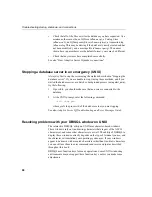
Working with databases
106
Each time you run
sp_iqestjoin
, select one of the suggested index sizes. If
you know you will always join the tables with exact one-to-one matches,
use the “Min Case index_size”. If you anticipate occasional one-to-many
joins, use the “Avg Case index_size”. If you anticipate using numerous
one-to-many joins, use the “Max Case index_size”.
4
Total the index_sizes you selected for all table pairs.
5
Add the join space total from step number 4 to the table space total from
step number 2, doing a separate calculation for minimum and maximum
join space.
6
Run the stored procedure
sp_iqestdbspaces
to determine how many
dbspaces to create from the given space and what size they should be. Use
the minimum and maximum total index sizes calculated in step number 5
as the minsize and maxsize parameters for this procedure, as follows:
sp_iqestdbspaces (
dbsize [,iqpagesize]
[,
minsize] [,maxsize] ...
All these calculations are estimates. Results vary based on the columns and
indexes you create for your database. For more information on these stored
procedures, see the Adaptive Server IQ Reference Manual.
Working with databases
Some application design systems, such as Sybase WarehouseArchitect, contain
facilities for creating database objects. These tools construct SQL statements
that are submitted to the server, typically through its ODBC interface. If you
are using one of these tools, you do not need to construct SQL statements to
create tables, assign permissions, and so on.
This chapter describes the SQL statements for defining database objects. You
can use these statements directly if you are building your database from an
interactive SQL tool, such as DBISQL. Even if you are using an application
design tool, you may want to use SQL statements to add features to the
database if they are not supported by the design tool.
For more advanced use, database design tools such as Sybase Warehouse
Architect provide a more thorough and reliable approach to developing well-
designed databases.
Summary of Contents for Adaptive Server IQ 12.4.2
Page 1: ...Administration and Performance Guide Adaptive Server IQ 12 4 2 ...
Page 16: ...xvi ...
Page 20: ...Related documents xx ...
Page 40: ...Compatibility with earlier versions 20 ...
Page 118: ...Troubleshooting startup shutdown and connections 98 ...
Page 248: ...Importing data by replication 228 ...
Page 306: ...Integrity rules in the system tables 286 ...
Page 334: ...Cursors in transactions 314 ...
Page 396: ...Users and permissions in the system tables 376 ...
Page 438: ...Determining your data backup and recovery strategy 418 ...
Page 484: ...Network performance 464 ...
Page 500: ...System utilities to monitor CPU use 480 ...
Page 514: ...Characteristics of Open Client and jConnect connections 494 ...
Page 536: ...Index 516 ...
















































